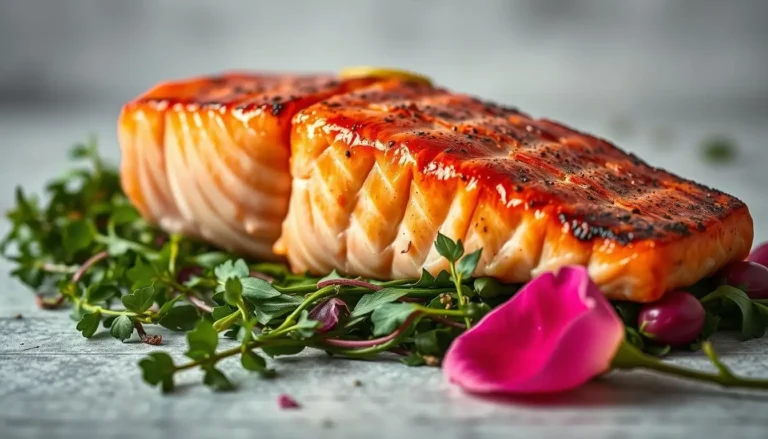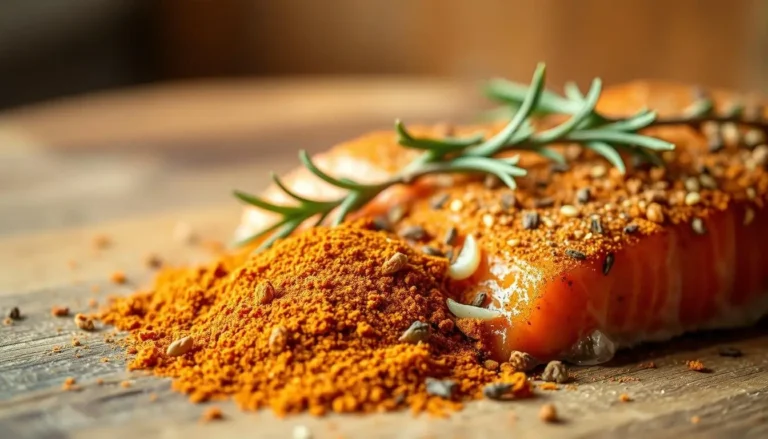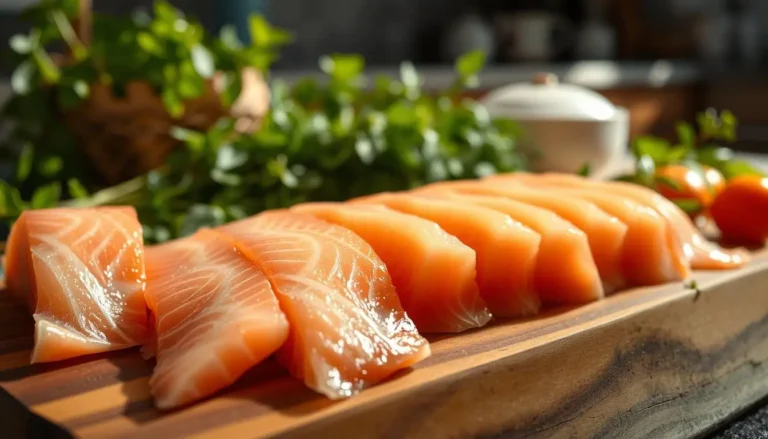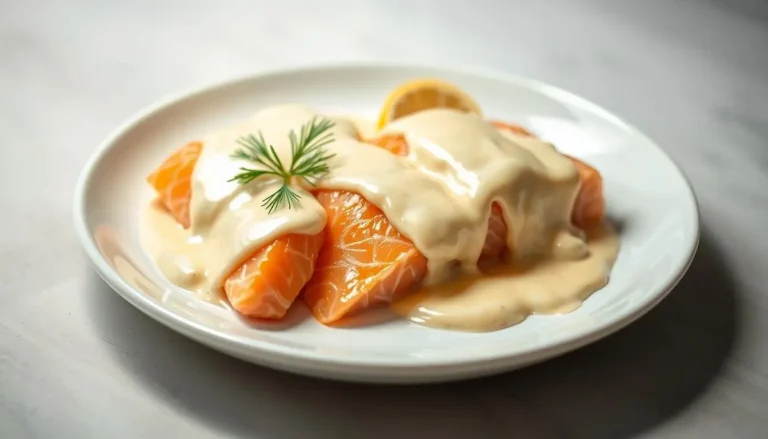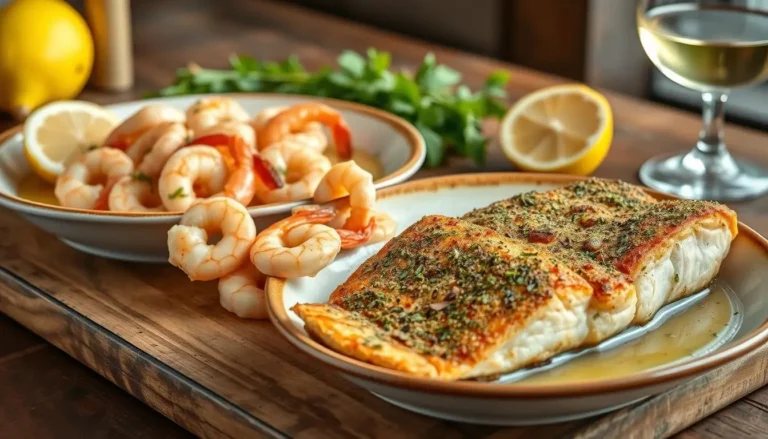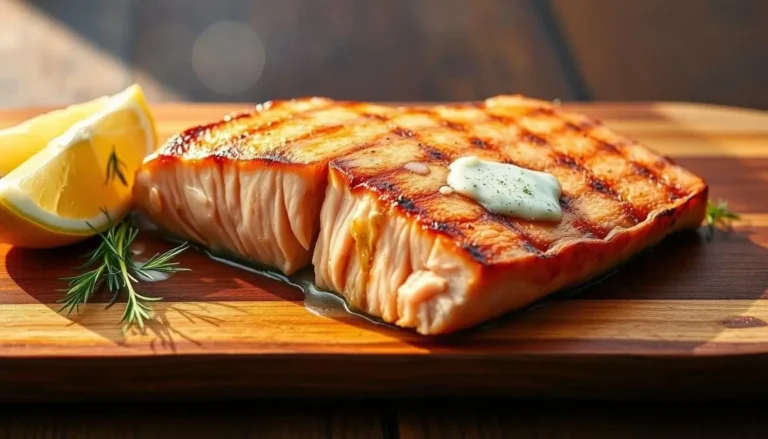Salmon and Spinach: Healthy and Flavorful Meal Ideas
Table of Contents
salmon and spinach recipes
It’s a busy Thursday evening, and you’re craving something nutritious but don’t want to spend hours in the kitchen. You grab a fresh fillet of mild fish, toss vibrant greens into a skillet with garlic and a splash of olive oil, and watch as golden sear marks form. In 20 minutes, you’re savoring a restaurant-worthy dish that’s as satisfying as it is simple.
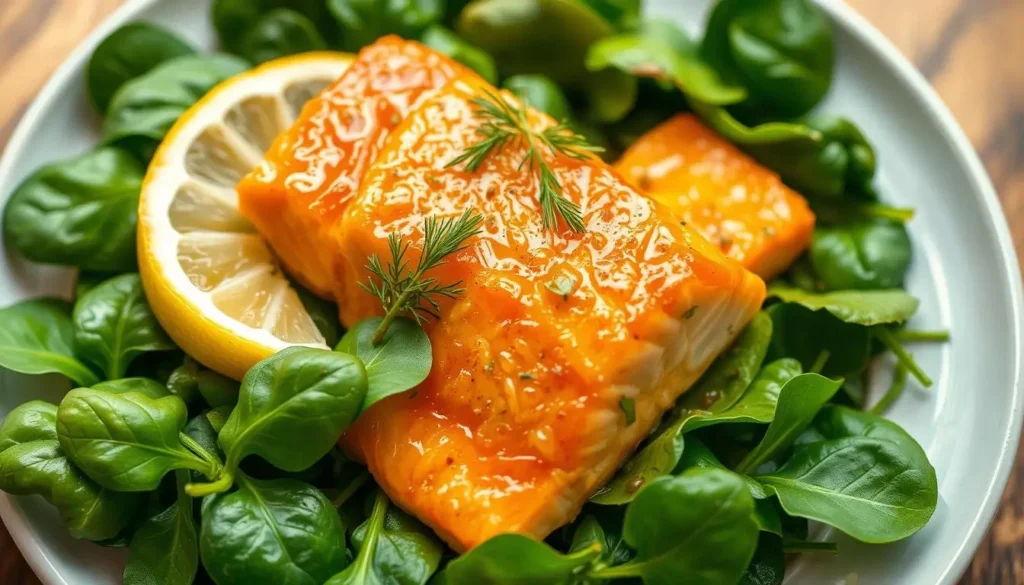
This article celebrates the magic of pairing protein-rich seafood with leafy greens. We’ll explore recipes inspired by creamy Tuscan-style dishes, one-pan techniques, and dinner party-worthy presentations. Whether you’re cooking for a date night or fueling a hectic week, these ideas adapt effortlessly.
You’ll discover how olive oil enhances flavor while keeping meals light. Master the art of harmonizing delicate fish fillets with sautéed greens to create a delightful contrast in textures. We’ll also share tips for boosting nutritional value without sacrificing taste—perfect for those prioritizing wellness.
Key Takeaways
- Combining seafood with leafy greens results in nutritious meals that are abundant in omega-3 fatty acids and essential vitamins.
- Creamy Tuscan-inspired recipes work for both casual dinners and special occasions.
- Pan-searing in olive oil develops flavor while keeping dishes heart-healthy.
- One-skillet methods save time and simplify cleanup.
- Presentation tricks elevate simple ingredients into impressive plates.
Discovering the Benefits of Salmon and Spinach
Ever wonder why chefs and nutritionists love pairing certain ingredients? This dynamic duo delivers exceptional health perks while creating vibrant flavors. Let’s break down why this combination works so well.
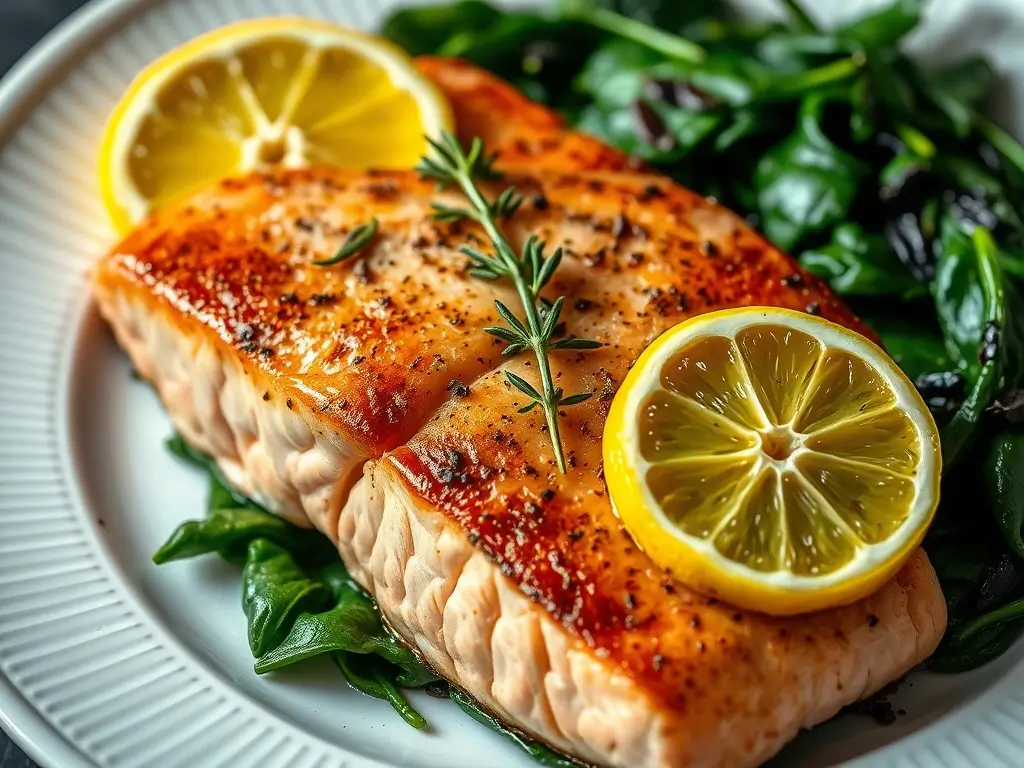
Fuel Your Body With Essential Nutrients
Protein-rich fish like this variety contains omega-3 fatty acids, known to support heart health and brain function. A single serving provides over 20 grams of protein, keeping you full longer. Pair it with dark leafy greens packed with iron, vitamin K, and fiber for a meal that nourishes from the inside out.
Unlock Layers of Flavor
A dash of sea salt and freshly cracked pepper enhances the inherent flavors without dominating them. Heat olive oil in a pan for 2 minutes to create a golden crust on the fish. Add garlic powder or Italian seasoning for aromatic depth—experiment with lemon zest for brightness.
Most recipes come together in under 30 minutes. Sear the protein for 4-5 minutes per side while wilting greens in the same pan. Serve with a side of quinoa or roasted veggies for balanced nutrition. The simplicity lets quality ingredients shine.
Essential Ingredients and Pantry Staples
The key to any unforgettable dish is found in its ingredients. Start with fresh, vibrant elements that deliver both taste and nutrition. A well-equipped kitchen allows you to create nutritious meals effortlessly, even on the busiest nights.
Fresh and Quality Salmon Selections
Opt for wild-caught fillets with firm texture and bright color—signs of peak freshness. Skin-on cuts develop crispy edges when seared. For quick dinners, pre-portioned frozen options work but thaw them properly to preserve moisture.
This protein source shines when paired with bold flavors. Keep basics like olive oil, sea salt, and cracked pepper handy. A dash of lemon elevates rich flavors without being overpowering.
Spinach and Complementary Ingredients
Choose crisp, deep-green leaves over wilted bunches. Baby varieties offer tender texture, while mature ones hold up in sauces. Garlic adds aromatic depth—use two cloves minced or sliced for balanced intensity.
Sun-dried tomatoes bring sweet-tart notes, while capers introduce briny contrast. For creamy sauces, swap heavy cream with coconut milk or half-and-half. Store these staples to transform simple dinners into restaurant-worthy plates.
Techniques for Searing and Cooking Salmon
Transform simple ingredients into restaurant-quality dishes by mastering essential cooking methods. Proper technique turns basic components into meals that impress both visually and on the palate. Let’s explore how to elevate your skills with precision and flair.
Mastering Pan Searing for Crisp Perfection
Start by heating a skillet over medium heat with a drizzle of olive oil. Pat your fillet dry—moisture prevents that golden crust. Season both sides with salt, pepper, and a hint of garlic powder for depth.
Place the skin side down first. Press gently to ensure even contact. Let it cook undisturbed for 3-4 minutes until edges crisp. Carefully turn the fillet with a spatula, then continue cooking the opposite side until it reaches a delicate opacity.
Controlling Heat and Timing for Ideal Texture
Take out the fillet after it’s done, reserving the pan drippings to create a sauce. Deglaze with broth or wine, scraping up flavorful bits. Stir in a teaspoon of herbs and a splash of cream for richness.
Keep the burner at medium-low to avoid burning. Drizzle the prepared sauce atop the fillet’s surface for an elegant sheen. This method locks in moisture while adding layers of flavor.
Creating a Rich and Creamy Spinach Sauce
The secret to restaurant-quality meals often lies in the sauce. A velvety blend transforms simple ingredients into something extraordinary, pairing perfectly with seared fish and leafy greens. Let’s craft a versatile base that elevates every bite.
Exploring Tuscan-Inspired Sauces
Start by heating olive oil in a skillet. Sauté minced garlic and diced shallots until fragrant—about 90 seconds. Add fresh cherry tomatoes and chopped sun-dried varieties for layered sweetness. Stir in a tablespoon of Italian herbs to awaken earthy flavors.
Gradually fold in baby leaves, letting them wilt into the mixture. This step preserves their vibrant color and fiber content. Pour in cream or coconut milk for dairy-free richness, simmering until the sauce thickens slightly.
Infusing Garlic, Olive Oil, and Cream
Balance richness with a squeeze of lemon juice—its acidity cuts through creaminess beautifully. For extra zest, add grated peel during the final minute of cooking. Stir constantly to prevent curdling and ensure silky texture.
Want to recreate this effortlessly? Printable recipe cards with step-by-step information are available through our resource links. These guides help you master sauce consistency while adapting flavors to personal taste.
Mastering salmon and spinach in Your Recipe
Bringing together perfectly cooked protein and vibrant greens requires precision. Start by patting your fillet dry and seasoning both sides with salt pepper. This simple step ensures a crisp skin and locks in natural juices during cooking.
Heat olive oil in a skillet over medium heat. Place the fillet skin-side down, pressing gently for even contact. Cook undisturbed for 4 minutes until golden, then flip to finish. Transfer to a plate using tongs—this is when you’ll remove salmon to build the sauce.
In the same pan, toss fresh spinach with minced garlic. Stir until leaves wilt but retain bright color. Pour in heavy cream or half and half, simmering gently to thicken. A squeeze of lemon juice cuts through richness, balancing the dish’s flavors.
Return the fillet to the skillet, nestling it into the creamy mixture. Let everything warm through for 2 minutes on low heat. This timing prevents overcooking while letting textures harmonize.
Mastering this salmon recipe lies in layering techniques. Crisp skin contrasts velvety sauce, while wilted greens add earthy depth. Serve immediately for a meal where every element shines.
Pairing and Serving Suggestions for a Balanced Meal
A well-rounded plate combines textures, colors, and nutrients in harmony. Thoughtful pairings enhance both taste and visual appeal, turning everyday dinners into memorable experiences. Let’s explore how to create cohesive meals that satisfy all senses.
Complementary Side Dishes and Grains
Pair your main dish with sides that contrast or amplify its flavors. Roasted root vegetables tossed in olive oil add caramelized sweetness, while garlic cauliflower rice offers a low-carb alternative with zesty notes. For quick prep, steam broccoli florets and drizzle with lemon juice.
| Side Dish | Flavor Pairing | Prep Time | Nutrition Boost |
| Roasted Vegetables | Herbs & Olive Oil | 25 mins | Fiber, Vitamins A & C |
| Garlic Cauliflower Rice | Lemon Zest | 15 mins | Low-carb, Antioxidants |
| Quinoa Pilaf | Toasted Almonds | 20 mins | Protein, Magnesium |
Warm sides in the same skillet used for cooking the fillet. This technique infuses them with residual garlic and herb flavors. Time everything to finish within 5 minutes of each other for peak freshness.
Presentation and Plating Tips
Place the fillet atop a bed of creamy sauce, letting it cascade slightly. Scatter vibrant greens around the edges for color contrast. Finish with a drizzle of olive oil and a sprinkle of finely chopped dill or parsley.
Use white plates to make colors pop. Add lemon wedges for a citrusy accent. Serve immediately to preserve the crispness of seared edges and the warmth of each component.
Conclusion
Mastering this dish proves that nutrient-dense meals can be both quick and luxurious. The pairing delivers omega-3s, iron, and vitamins through simple techniques—searing protein to crisp perfection and wilting greens in aromatic sauces. Whether using fresh or frozen ingredients, you’ll create restaurant-quality plates in under 30 minutes.
Start with quality olive oil and proper heat control for golden crusts. Build flavor layers with garlic, lemon, and herbs—then balance richness with bright citrus notes. This recipe adapts effortlessly: swap cream for coconut milk or add sun-dried tomatoes for extra depth.
Serve your creation with roasted vegetables or quinoa for textural contrast. The dish shines at casual dinners and special occasions alike. Share your twists using smoked paprika or caramelized onions, and invite friends to explore these techniques.
Ready to make it yours? Print our step-by-step guide, tag us in your creations, and revisit for more meal inspiration. Every bite celebrates how smart cooking meets vibrant flavor.
FAQ
Can I use frozen fillets instead of fresh ones ?
Yes, but thaw them thoroughly in the fridge first. Pat dry with paper towels to ensure proper searing and avoid excess moisture during cooking.
How do I prevent overcooking the fish ?
Use medium heat and cook skin-side down for 4-5 minutes. Flip only once, then finish cooking for 2-3 minutes. The internal temperature should reach 145°F (63°C).
What’s a dairy-free alternative for creamy sauces ?
Substitute heavy cream with coconut milk or cashew cream. Add lemon juice or nutritional yeast to enhance richness without dairy products.
Can I prepare this dish ahead of time ?
Cook components separately. Store seared fillets and sautéed greens in airtight containers. Reheat gently in a pan with olive oil to preserve texture.
Which sides pair well with this recipe ?
Opt for quinoa, roasted potatoes, or steamed asparagus. These balance the meal’s protein and fiber content while adding varied textures.
How do I achieve crispy skin without burning ?
Start with a hot skillet and olive oil. Press the fillet skin-side down firmly for 30 seconds to ensure even contact. Reduce heat slightly if needed.
Is there a low-sodium option for seasoning ?
Replace table salt with herbs like dill, thyme, or smoked paprika. A splash of citrus zest also boosts flavor without added sodium.

